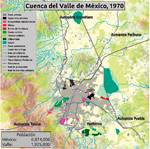Cartography of the real estate tsunami: the popular urban movement and the urban-rural links of the real estate boom in Mexico City
DOI:
https://doi.org/10.15381/espiral.v1i1.15843Keywords:
Real-estate boom; popular urban movement; Mexico City., TsunamiAbstract
Mexico City is one of the oldest and largest urban concentrations in the world. It constitutes a vast
concentration of labor power and means of production that represents a formidable capacity for
extracting profits, and requires a complex management for its control. In recent years the battle for
the metropolis has become more acute and is currently expressed in the expansion of real estate
developments, named by popular urban movement as the real estate tsunami. This is the densification
of the urban core from the vertical expansion of the city through the construction of housing towers,
but also through the expansion of new transport networks such as MetroBus (Bus Rapid Transport) and
the overlap of controlled access roads, the expansion of shopping centers, the privatization of public
spaces (pocket parks), the elimination of unbuilt spaces, the displacement of the poorest population of
urban centers from violent dispossessions and evictions and its replacement with vertical overcrowding
of a long-term indebted population with the real estate industry. To understand this new phase of
urban expansion, a cartography of this real estate tsunami is carried out, under the assumption that
making visible the coordination of business and state strategies of appropriation of urban land, allows to
understand and fundamentally strengthen the popular urban movements.

Downloads
Published
Issue
Section
License
Copyright (c) 2019 Adrián Flores

This work is licensed under a Creative Commons Attribution-NonCommercial-ShareAlike 4.0 International License.
LOS AUTORES RETIENEN SUS DERECHOS:
a. Los autores retienen sus derechos de marca y patente, y también sobre cualquier proceso o procedimiento descrito en el artículo.
b. Los autores retienen el derecho de compartir, copiar, distribuir, ejecutar y comunicar públicamente el artículo publicado en la revista Espiral (por ejemplo, colocarlo en un repositorio institucional o publicarlo en un libro), con un reconocimiento de su publicación inicial en la revista Espiral.
c. Los autores retienen el derecho a hacer una posterior publicación de su trabajo, de utilizar el artículo o cualquier parte de aquel (por ejemplo: una compilación de sus trabajos, notas para conferencias, tesis, o para un libro), siempre que indiquen la fuente de publicación (autores del trabajo, revista, volumen, número y fecha).





